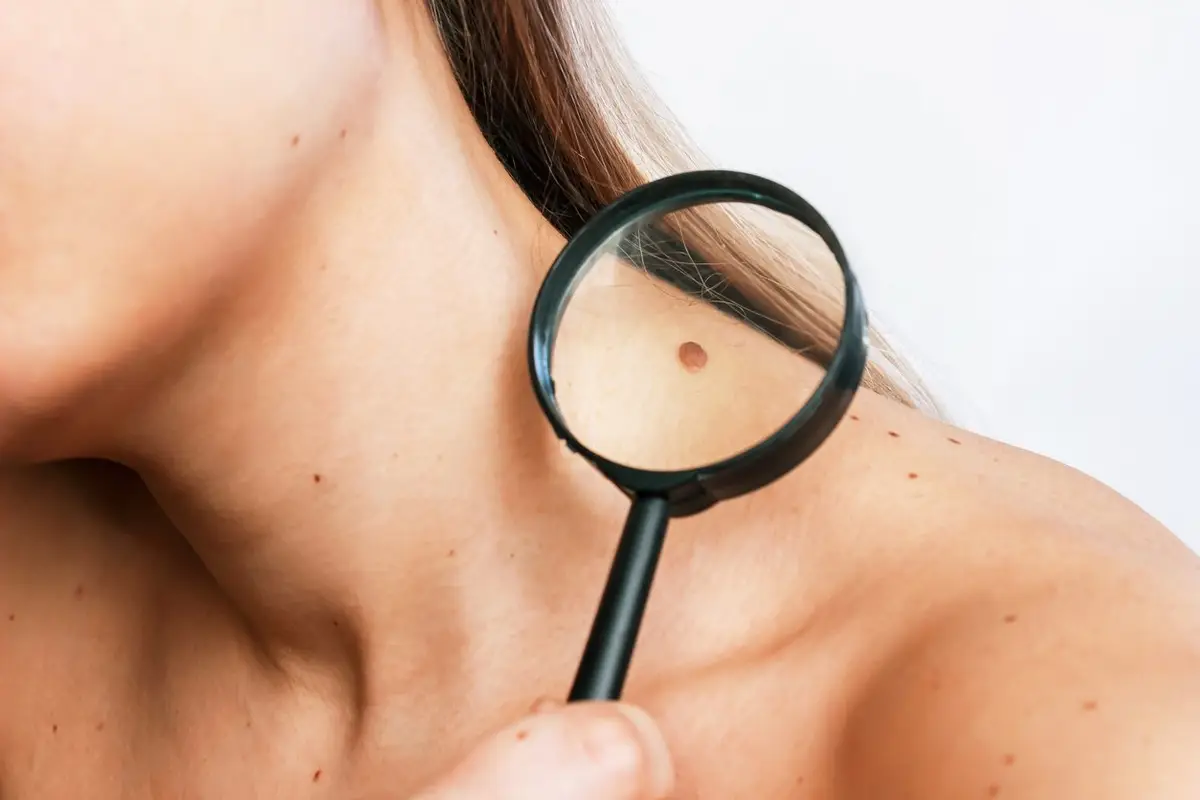Your skin is the largest organ in the body, so it makes sense that skin cancer is the most common type of cancer. But did you know that rates of melanoma — the most deadly form of skin cancer — have been on the rise for women?
More than 39,000 women will be diagnosed with melanoma this year. And if these stats have you reaching for the sunscreen, here’s more on what you need to know about symptoms of melanoma and how to protect your skin.
What is melanoma and what causes it?
Melanoma, also called cutaneous melanoma, is the most serious type of skin cancer. It happens when melanocytes, the cells that give your skin its color, become damaged and grow out of control. Unlike other types of skin cancer, it can spread quickly to other parts of the body.
There are three types of cells that make up the top layer of your skin, known as the epidermis: squamous cells, basal cells and melanocytes. Squamous cell carcinoma is cancer on the top layer of the skin. It usually occurs in areas of your body that get the most sun. It can metastasize, or spread, to other parts of your body. Basal cell carcinoma is the most common type of skin cancer. It grows slowly and doesn’t tend to spread to other areas. Melanocytes are the bottom layer and, in addition to making melanin, the substance in your body that produces hair, eye and skin color, it also helps protect the deeper layers of skin from the sun’s ultraviolet (UV) radiation.
There are four types of melanoma:
- Superficial spreading melanoma: The most common form, typically found on the legs and upper back in women. It usually looks flat and discolored.
- Lentigo maligna melanoma: Typically appears in older adults and looks similar to the superficial spreading form, appearing flat with blotchy patches of blue-black, tan or brown.
- Acral lentiginous melanoma: The most common melanoma in people of color, appearing black or brown in color. It can develop under the nails, on the palms or on the soles of the feet.
- Nodular melanoma: This is the most aggressive form of melanoma and it tends to grow quickly. Appears as a bump, reddish or blue-black in color.
Researchers aren’t exactly sure how melanoma forms, but genetics and environment might play a role. Exposure to UV rays from the sun or tanning beds increases your risk of developing melanoma.
What are the risk factors for melanoma?
The risk factors that can lead to melanoma, include:
- A personal or family history of melanoma, since melanoma can be hereditary
- Past breast or thyroid cancer
- Having fair skin, blond or red hair, freckles, or blue eyes
- Extensive exposure to the sun, including getting sunburns that blister
- Using tanning beds
- Having numerous moles on the body, especially if they’re large or irregular-shaped borders
- Having a weak immune system
- Being over age 50
Race also plays a role in risk factors. White people are more at risk for melanoma than people of color because they have less protective melanin in lighter skin. However, people of color are more likely to die from the disease because they often develop melanoma in parts of their body that don’t get sun exposure and experience delays in being diagnosed.
What are the symptoms of melanoma?
Melanoma most commonly occurs on the back, arms, legs and face. It also can appear on the palms, soles of the feet, nailbeds, inside the mouth and on the genitals, particularly in those with darker skin.
Early-stage melanoma usually first appears as a rapidly growing irregular new mole or a change in a mole you already have. Most melanomas are new growths rather than from an established mole. You might also notice an unusual growth or pigmented areas that weren’t there before. For warning signs of melanoma, follow ABCDE:
- Asymmetrical — Moles or spots have an irregular shape
- Border — The border, or outline of the area, is irregular or jagged
- Color — There’s an uneven amount of color
- Diameter — A mole or spot that is larger than the size of a pea
- Evolving — A mole or spot that has changed in the last few weeks or months
How is melanoma diagnosed?
If a mole or spot looks suspicious, your healthcare provider (HCP), often a dermatologist who specializes in skin conditions, will order a biopsy. A biopsy is when a small part of the affected area is removed and studied under a microscope. If cancer cells are found, your HCP may want to stage the cancer, including finding out if the cancer has metastasized, or spread.
For a deeper tumor, you may need to get imaging to help your doctor stage your cancer, such as a computed tomography (CT) scan, magnetic resonance imaging (MRI) or positron emission tomography (PET).
There are five stages of melanoma:
- Stage 0: Also known as melanoma in situ, the cancer is only located in the epidermis (the outer layer of skin)
- Stage 1: The cancer hasn’t spread to other areas and can be cured with surgery
- Stage 2: The cancer hasn’t spread but has a higher chance of returning
- Stage 3: Cancer has spread to nearby lymph nodes or skin
- Stage 4: Cancer has spread to distant lymph nodes, skin or other organs
What are treatment options for melanoma?
Surgery to remove melanoma tends to be the most successful treatment. In early cancer stages, your doctor will remove the cancerous area as well as some surrounding skin. A lymphadenectomy is a surgery that also may be done if you need to have lymph nodes removed.
Chemotherapy might be done to kill remaining cancer cells, but more often, your doctor may use immunotherapy or targeted therapy instead. Immunotherapy uses your own immune system to kill cancer cells and might be used in addition to surgery. In targeted therapy, certain medications kill off cancer cells and shrink cancer.
Radiation therapy might also be used to destroy the cancerous cells and prevent new cancer cells from growing.
Can melanoma be prevented?
Some cases of melanoma can be prevented. Steps you can take to prevent melanoma include:
- Stay out of the sun during the most intense part of the day, usually between 10 a.m. and 4 p.m., even when it’s cloudy.
- Use sunscreen with an SPF of 30 or more all year round, and make sure you’re applying it every two hours.
- Wear sunglasses that block both UVA and UVB rays.
- Make sure your skin is covered in protective clothing when outside and wear a hat with a brim.
- Don’t use tanning beds.
- Inspect your skin regularly and check whether you have any new moles or moles that have changed in appearance.
Talk with your HCP if you notice anything suspicious on your skin and consider seeing a dermatologist for regular skin checks. And try not to panic if there is something concerning. Not all suspicious moles or spots are cancer, so practice your ABCDEs.
Melanoma Resource List
HealthyWomen Resources
- My Melanoma Was Dismissed as an Inflamed Hair Follicle
- The ABCDEs of Spotting Melanoma
- Why Are People of Color More Likely to Die from Skin Cancer?
- I Was Wrong to Think Ethnicity Made Me Immune to Skin Cancer
- What Is Melanoma? A Reel by Dr. Obioha
En Español
- El ABCDE para identificar melanomas
- Melanoma 101 — Risk Factors, Diagnosis, Stages and Treatment
- Estaba equivocada al pensar que la etnia me hizo inmune al cáncer de piel
- ¿Por qué las personas de color tienen más probabilidades de morir de cáncer de piel?
Additional Resources
- Melanoma - Symptoms and causes
- Melanoma Skin Cancer | Understanding Melanoma
- Racial Disparities in Skin Cancer Diagnosis, Prognosis, and Treatment - Oncology Nurse Advisor
- How to prevent skin cancer (aad.org)
- Black Derm Directory | BDD | Skin of Color Dermatology
This resource was created with support from Merck.
- The ABCDEs of Spotting Melanoma ›
- Fact or Fiction? Sun Safety Quiz - HealthyWomen ›
- Fast Facts: What You Need to Know About Skin Cancer - HealthyWomen ›
- What Is Melanoma? A Reel by Dr. Obioha - HealthyWomen ›
- What Is Melanoma and Why Are Melanoma Rates Increasing? - HealthyWomen ›
- Skin Cancer Warning Signs - HealthyWomen ›
- Types of Melanoma - HealthyWomen ›
- Tipos de melanoma - HealthyWomen ›
- Immunotherapy for Melanoma - HealthyWomen ›
- Inmunoterapia para el melanoma - HealthyWomen ›
- Tanning led to melanoma at a young age - HealthyWomen ›
- Tuve melanoma a una edad temprana por broncearme - HealthyWomen ›
- Skin Cancer - HealthyWomen ›




